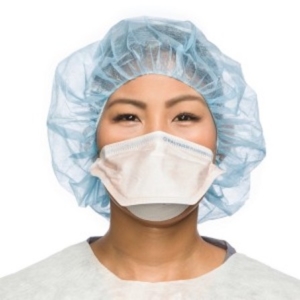3 things to consider when selecting facial protection in the healthcare setting
1. There are different types of medical face masks.
Generally speaking, face masks fall into three key sub-groups: procedure masks, surgical tie masks, and N95 respirators. Masks that are authorized by the FDA are referred to as medical face masks.
Visually, the easiest way to tell masks apart is by the attachment that fixes it to the face. Procedure masks are affixed with stretch loops behind the ears, while surgical tie masks, which are intended for use in the operating room, have two sets of ties for a more secure fit to the face. NIOSH-approved N95 respirators have over the head elastic bands, or head straps, to hold the respirator firmly in place and create a seal, creating their high level of protection.
There are industry-specific standards that measure mask performance that also impacts where the mask should be used in the healthcare setting. ASTM International develops and publishes voluntary consensus standards for a wide variety of products and services. These standards serve as a baseline to help ensure safety and quality. To carry an ASTM rating, the FDA requires that the mask be tested for bacterial filtration, differential pressure (breathability), particulate filtration, fluid resistance and resistance to flame spread. Depending on the test results, a mask may be rated ASTM level 1, 2 or 3 with the highest performance rated level 3. A mask that has an ASTM level 1 protection should not be used in areas where there is moderate to high risk of fluid exposure.
Surgical N95 respirators have been approved by NIOSH and have been authorized for use by the FDA. Not all N95 respirators are approved as surgical face masks. A surgical N95, also referred to as a medical respirator, provides protection from both airborne and fluid hazards (e.g., splashes, sprays). Per the CDC, surgical N95s should be reserved for use by healthcare personnel.1
While not all N95s are the same, they must filter at least 95% of very small particles, including bacteria and viruses from the air, breathed through the mask.2
You may see references to KN95s. These are made and certified in China and are not approved by NIOSH.
2. Medical masks are intended for single use.
Surgical tie and procedure masks, along with surgical N95 respirators meant for use in medical settings are made primarily with non-woven fabrics, along with a filter material called meltblown. The combination of materials are designed to protect the wearer and the patient from the transfer of microorganisms, splashes of blood, or other droplets of potentially infectious bodily fluids.3
Procedure, surgical tie and even surgical N95 respirators are disposable medical products and are intended for single use only which is clearly reflected on the product labeling. They should be disposed of once used in accordance with the healthcare facility’s policy.
3. Wearers should be fit-tested before wearing a N95 respirator.
Unlike a surgical tie or procedure mask, the Occupational Safety and Health Administration (OSHA) requires that each healthcare employee who needs to use an N95 respirator for their job be fit-tested to ensure air is only passing through the mask and not venting out the sides. A snug individual fit is essential to achieve this higher level of protection, and it applies for any type or brand of surgical N95. Fit-testing information is kept in each employee’s file, and OSHA may review files during on-site inspections.
To learn more and review facial protection in your facility, contact your O&M HALYARD representative.
Sources:
1.Centers for Disease Control and Prevention. (2022, January 14). Types of Masks and Respirators. Retrieved January 25, 2022 from https://www.cdc.gov/coronavirus/2019-ncov/prevent-getting-sick/types-of-masks.html
2. Centers for Disease Control and Prevention. (2021, April 9). Personal Protective Equipment: Questions and Answers. Retrieved November 12, 2021 from https://www.cdc.gov/coronavirus/2019-ncov/hcp/respirator-use-faq.html 3. Benson, S. Novak, D. Ogg, M. April 2013. Proper Use of Surgical N95 Respirators and Surgical Masks in the OR. AORN Journal. 457-470
3. Benson, S. Novak, D. Ogg, M. April 2013. Proper Use of Surgical N95 Respirators and Surgical Masks in the OR. AORN Journal. 457-470

